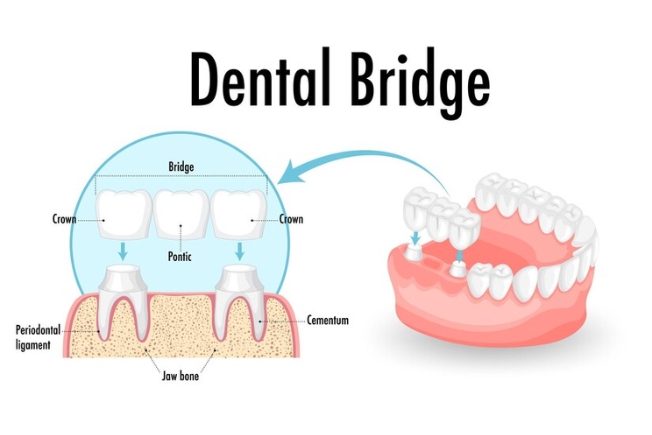
As the Thanksgiving season approaches, we’re all excited about family gatherings, festive meals, and expressing gratitude. But have you ever thought about giving thanks for your smile? Dental bridges offer a fantastic solution to restore your smile and ensure you feel confident while enjoying all the Thanksgiving delicacies.
If you’re dealing with missing teeth, dental bridges could be just the “treat” your teeth need this season. In this blog, we will explore what dental bridges are, the types available, their benefits, and how they work—so you can make an informed decision for your oral health.
What’s a Dental Bridge Again?
A dental bridge is a prosthetic device used to replace one or more missing teeth by “bridging” the gap between healthy teeth or implants. It is typically made up of crowns for the teeth on either side of the gap and a false tooth (or teeth) in between.
These prosthetics are designed to restore function, improve the appearance of your smile, and prevent dental problems that may arise from missing teeth.
Why You Might Need One?
Missing teeth can lead to a variety of oral health issues, such as:
- Difficulty chewing or speaking: Missing teeth can make everyday tasks, like eating and talking, more challenging.
- Shifted teeth: When there is a gap in your smile, adjacent teeth may shift into the space, leading to misalignment.
- Jawbone deterioration: When teeth are missing, the bone that previously supported them can begin to deteriorate, leading to further tooth loss.
A dental bridge can solve these problems, making it an essential option for restoring both function and appearance.
Types of Dental Bridges
Dental bridges come in several different types, depending on the patient’s needs and the specific condition of their mouth. Each type of bridge offers different benefits, and our dentist will recommend the one that best suits your oral health.
1. Traditional Dental Bridges
- Description: Traditional bridges are the most common type and are used when there are natural teeth on both sides of the gap. The prosthetic tooth is anchored to dental crowns that are placed over the existing healthy teeth.
- Benefits: These are highly durable and provide a strong solution for restoring missing teeth.
2. Cantilever Bridges
- Description: Cantilever bridges are used when there is only one natural tooth available next to the gap. A crown is placed on this tooth, and the false tooth extends from it.
- Benefits: These bridges are ideal when there is only one adjacent tooth available to support the bridge.
3. Maryland Bridges (Resin-Bonded Bridges)
- Description: Maryland bridges consist of a false tooth supported by a metal or porcelain framework that bonds to the back of the adjacent teeth. These are less invasive than traditional bridges.
- Benefits: This option is more conservative and does not require extensive alteration of healthy teeth.
4. Implant-Supported Bridges
- Description: Implant-supported bridges are a more modern solution. Instead of using natural teeth for support, the bridge is anchored to dental implants, which are titanium posts placed into the jawbone.
- Benefits: These provide a strong, permanent solution and are ideal for patients with multiple missing teeth.
Benefits of Dental Bridges
Dental bridges are more than just a cosmetic fix—they offer a wide range of benefits for your oral health:
1. Better Functionality
- Bridges restore your ability to chew and speak properly, making it easier to enjoy your Thanksgiving dinner without discomfort or embarrassment.
2. Enhanced Aesthetic Appeal
- Missing teeth can affect your smile, but dental bridges look and feel like natural teeth. They help you smile with confidence during holiday photos and family gatherings.
3. Prevents Tooth Shifting
- A missing tooth can cause the adjacent teeth to shift into the gap, leading to misalignment and bite problems. A dental bridge prevents this by filling the space with a false tooth.
4. Prevents Bone Loss
- When teeth are lost, the underlying jawbone can begin to deteriorate. By placing a dental bridge, especially when supported by implants, the jawbone is stimulated, helping to preserve its structure.
5. Quick and Effective Treatment
- Dental bridges can often be placed in just a few visits, making them a relatively quick and efficient solution for restoring missing teeth.
The Dental Bridge Procedure
Getting a dental bridge typically requires multiple visits to the dentist. Here’s what you can expect during the procedure:
- Initial Consultation
- Our dentist will examine your mouth, take X-rays, and determine if a dental bridge is the best solution for you.
- Our dentist will examine your mouth, take X-rays, and determine if a dental bridge is the best solution for you.
- Preparing the Teeth
- If you’re receiving a traditional or cantilever bridge, the neighboring teeth will be reshaped to accommodate the crowns. For implant-supported bridges, dental implants will be placed in the jawbone first.
- If you’re receiving a traditional or cantilever bridge, the neighboring teeth will be reshaped to accommodate the crowns. For implant-supported bridges, dental implants will be placed in the jawbone first.
- Taking Impressions
- Once the teeth are prepared, impressions of your teeth are taken to create a custom bridge that will fit your mouth precisely.
- Once the teeth are prepared, impressions of your teeth are taken to create a custom bridge that will fit your mouth precisely.
- Temporary Bridge
- While your permanent bridge is being made, a temporary bridge may be placed to protect your teeth and gums.
- While your permanent bridge is being made, a temporary bridge may be placed to protect your teeth and gums.
- Final Placement
- When your permanent bridge is ready, the dentist will ensure it fits properly and make any necessary adjustments before cementing it into place.
Take Care Of Your Dental Bridge
Once you’ve received your dental bridge, it’s important to take proper care of it to ensure its longevity:
- Brush and Floss Regularly: Maintain a good oral hygiene routine to prevent plaque buildup around the bridge. Be sure to floss under the bridge to keep the gums healthy.
- Avoid Hard or Sticky Foods: While dental bridges are durable, chewing on hard foods (like ice) or sticky candies can damage or dislodge the bridge.
- Visit Dentists Timely: Regular check-ups allow the dentist to monitor the condition of your bridge and make adjustments if needed.
Be Thankful For a Restored Smile!
This Thanksgiving, why not give thanks for your smile? Dental bridges offer an excellent solution for restoring missing teeth improving your ability to eat, speak, and smile confidently. Whether you’re enjoying a traditional turkey dinner or a slice of pumpkin pie, dental bridges can help you enjoy your meals without worry.
If you’re dealing with missing teeth, talk to our dentist about whether a dental bridge is right for you. A healthy smile is one of the best gifts you can give yourself this holiday season—and for many Thanksgivings to come!

